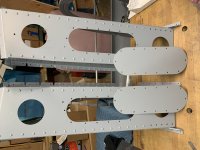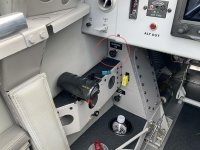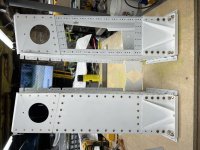I want to do the gear tower mod, but I was wondering if it could be done in a different way than the two options regularly discussed. I'm not sure if this way has been discussed before and I don't know if it's feasible. So I would love some input from experienced builders.
I think the tower would look better without the lightening holes. Also, removing the web between the two lightening holes or cutting F-802C-(L/R)-1 into three parts must have some structural impact, though it may be inconsequential.
What I am wondering is if it would be possible to fabricate a replacement part without lightening holes that was attached entirely with flush screws to the side angles and hex bolts on the flange that attaches to the longerons. I can't tell from the plans, but it looks like you could reach up under the panel with a wrench to remove the bolts attaching it to the longeron. It sounds like a bit of a pain, but I guess you would only have the remove the longeron bolts once a year (maybe less if you flip the gear bolts?). I also can't tell from the plans if there would be enough space for the bolt heads on top of the longeron with the forward skin in place.
Has anyone tried this? Can anyone think why it wouldn't work or would be a bad idea?
I think the tower would look better without the lightening holes. Also, removing the web between the two lightening holes or cutting F-802C-(L/R)-1 into three parts must have some structural impact, though it may be inconsequential.
What I am wondering is if it would be possible to fabricate a replacement part without lightening holes that was attached entirely with flush screws to the side angles and hex bolts on the flange that attaches to the longerons. I can't tell from the plans, but it looks like you could reach up under the panel with a wrench to remove the bolts attaching it to the longeron. It sounds like a bit of a pain, but I guess you would only have the remove the longeron bolts once a year (maybe less if you flip the gear bolts?). I also can't tell from the plans if there would be enough space for the bolt heads on top of the longeron with the forward skin in place.
Has anyone tried this? Can anyone think why it wouldn't work or would be a bad idea?







